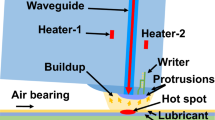Abstract
Heat-assisted magnetic recording (HAMR) is a technique for overcoming the superparamagnetic limit and enabling large increases in the storage density of hard disk drives. The performance of the disk carbon overcoat under the high temperature in the heating-assisted writing process is a concern. Laser heating in HAMR is quite different from conventional slow heating. Laser heating temperature and total laser heating duration over the lifetime of the drive are two dominant factors in the experimental study of laser-heating-induced damage to the carbon overcoat, which must be carefully controlled. In this study, a rough estimation of the total laser heating time for a given point on the media over the 5-year lifetime of the drive is given. It is expected to be only 0.1 ms. The methods of controlling laser heating temperature and total laser heating time in experimental studies are explained in detail. Laser-heating-induced damage to the a-C:Nx and a-C:Hx overcoats on HAMR media are studied. Surface topographical changes caused by the laser heating are evaluated with atomic force microscopy and structure changes by visible Raman spectroscopy. It is found that laser heating induces surface topographical and structure changes, especially for the a-C:Nx overcoat.









Similar content being viewed by others
References
Weller, D., Moser, A.: Thermal effect limits in ultrahigh-density magnetic recording. IEEE Trans. Magn. 35, 4423–4439 (1999)
Tagawa, N., Andoh, H., Tani, H.: Study on lubricant depletion induced by laser heating in thermally assisted magnetic recording systems: effect of lubricant thickness and bonding ratio. Tribol. Lett. 37, 411–418 (2010)
Tagawa, N., Tani, H.: Lubricant depletion characteristics induced by rapid laser heating in thermally assisted magnetic recording. IEEE Trans. Magn. 47, 105–110 (2011)
Ma, Y.S., Gongaza, L., An, C.W., Liu, B.: Effect of laser heating duration on lubricant depletion in heat assisted magnetic recording. IEEE Trans. Magn. 47, 3445–3448 (2011)
Ma, Y.S., Chen, X.Y., Zhao, J.M., Yu, S.K., Liu, B., Seet, H.L., Ng, K.K., Hu, J.F., Shi, J.Z.: Experimental study of lubricant depletion in heat assisted magnetic recording. IEEE Trans. Magn. 48, 1813–1818 (2012)
Ma, Y.S., Chen, X.Y., Liu, B.: Experimental study of lubricant depletion in heat assisted magnetic recording over the lifetime of the drive. Tribol. Lett. 47, 175–182 (2012)
Tagawa, N., Miki, T., Tani, H.: Depletion of monolayer liquid lubricant films induced by laser heating in thermally assisted magnetic recording. Tribol. Lett. 47, 123–129 (2012)
Tagawa, N., Kakitani, R., Tani, H., Iketani, N., Nakano, I.: Study of lubricant depletion induced by laser heating in thermally assisted magnetic recording systems—effect of lubricant film materials. IEEE Trans. Magn. 45, 877–882 (2009)
Ma, Y.S., Chen, X.Y., Liu, B.: Experimental study of lubricant depletion in heat-assisted magnetic recording: effect of the duration of one laser heating. Tribol. Lett. 48, 337–344 (2012)
Ma, Y.S., Chen, X.Y., Liu, B.: Experimental study of lubricant depletion in heat assisted magnetic recording: effects of laser heating duration and temperature. Microsyst. Technol. 19, 291–297 (2013)
Wang, N., Komvopoulos, K.: Thermal stability of ultrathin amorphous carbon films for energy-assisted magnetic recording. IEEE Trans. Magn. 47, 2277–2282 (2011)
Kryder, M.H., Gage, E.C., McDaniel, T.W., Challener, W.A., Rottmayer, R.E., Ju, G., Hsia, Y.-T., Erden, M.F.: Heat assisted magnetic recording. Proc. IEEE 96, 1810–1835 (2008)
Ferrari, A.C., Kleinsorge, B., Morrison, N.A., Hart, A., Stolojan, V., Robertson, J.: Stress reduction and bond stability during thermal annealing of tetrahedral amorphous carbon. J. Appl. Phys. 85, 7191–7197 (1999)
Orwa, J.O., Andrienko, I., Peng, J.L., Prawer, S., Zhang, Y.B., Lau, S.P.: Thermally induced sp 2 clustering in tetrahedral amorphous carbon (ta-C) films. J. Appl. Phys. 96, 6286–6297 (2004)
Robertson, J.: Diamond-like amorphous carbon. Mater Sci Eng R 37, 129–281 (2002)
Conway, N.M.J., Ferrari, A.C., Flewitt, A.J., Robertson, J., Milne, W.I., Tagliaferro, A., Beyer, W.: Defect and disorder reduction by annealing in hydrogenated tetrahedral amorphous carbon. Diam. Relat. Mater. 9, 765–770 (2000)
McCann, R., Roy, S.S., Papakonstantinou, P., Bain, M.F., Gamble, H.S., McLaughlin, J.A.: Chemical bonding modifications of tetrahedral amorphous carbon and nitrogenated tetrahedral amorphous carbon films induced by rapid thermal annealing. Thin Solid Films 482, 34–40 (2005)
Friedmann, T.A., McCarty, K.F., Barbour, J.C., Siegal, M.P., Dibble, D.C.: Thermal stability of amorphous carbon films grown by pulsed laser deposition. Appl. Phys. Lett. 68, 1643–1645 (1996)
Author information
Authors and Affiliations
Corresponding author
Rights and permissions
About this article
Cite this article
Ma, Y.S., Man, Y.J., Shakerzadeh, M. et al. Laser-Heating-Induced Damage to Ultrathin Carbon Overcoat in Heat-Assisted Magnetic Recording. Tribol Lett 53, 303–310 (2014). https://doi.org/10.1007/s11249-013-0268-x
Received:
Accepted:
Published:
Issue Date:
DOI: https://doi.org/10.1007/s11249-013-0268-x




